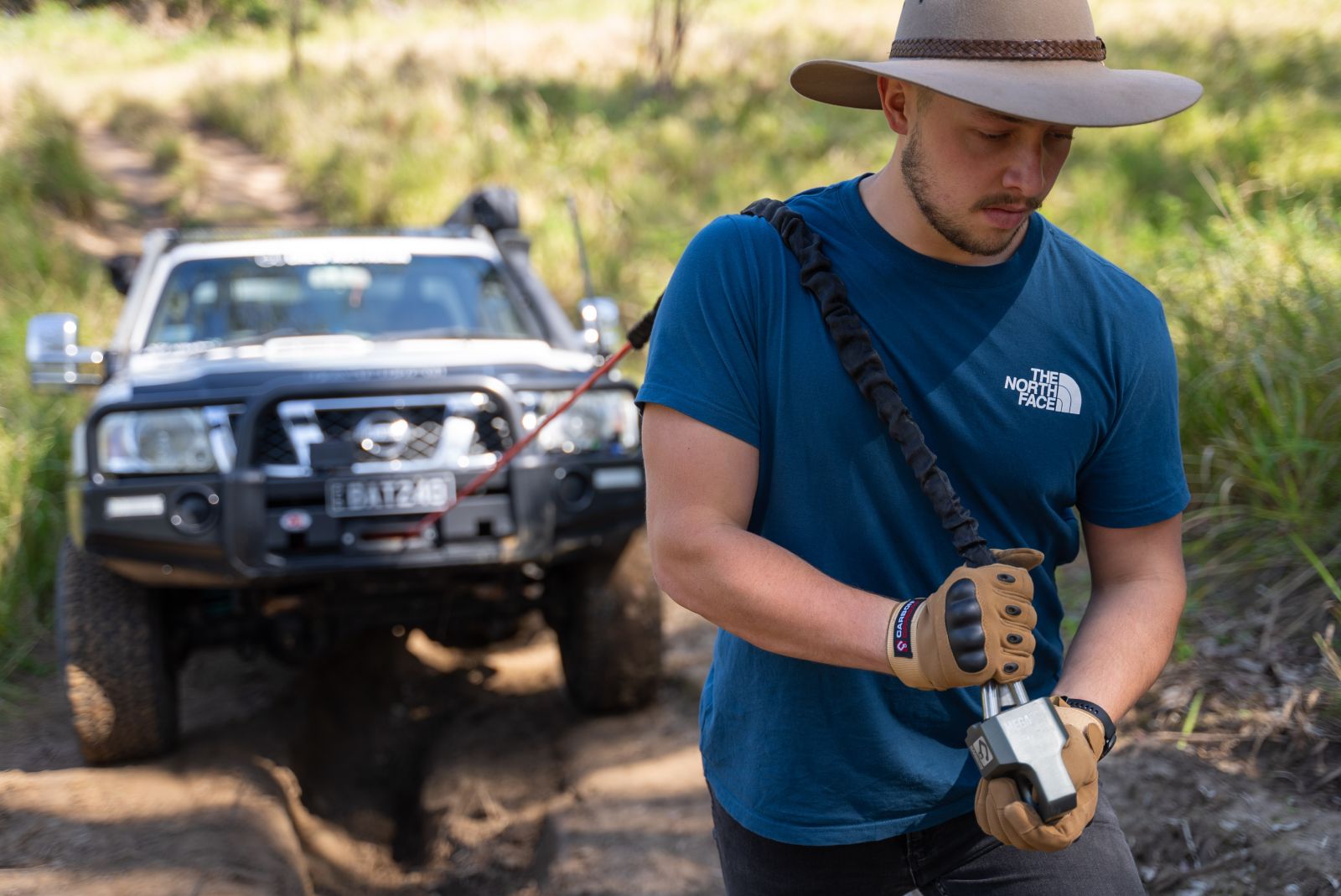 A 4x4 winch is one of the few 4x4 recovery accessories that gives the strongest sense of security when exploring hard tracks. The front 4x4 winch is what you rely on when the other parts of your 4x4 stop working, no matter how powerful the engine, tricky the suspension, or nasty the tyres on your rig may be, your lifeline is a winch.
A 4x4 winch is one of the few 4x4 recovery accessories that gives the strongest sense of security when exploring hard tracks. The front 4x4 winch is what you rely on when the other parts of your 4x4 stop working, no matter how powerful the engine, tricky the suspension, or nasty the tyres on your rig may be, your lifeline is a winch.
Longer than many of us have lived, winches have been a staple of four-wheeling adventures. They have changed through time to become a valuable tool that is frequently bought once and then transported from rig to rig. 4x4 winches can range from $200 to over $2k depending on your needs and quality.
When picking a 4x4 winch, four-wheelers who make that kind of investment must carefully take all the variables into account. As you go through the following material, have the following crucial idea in mind to help you make your decision: Purchasing a 4x4 winch is comparable to purchasing a pair of boots in that what appeals to one person's eyes and senses may not be appropriate for another.
The ideal 4x4 winch would be affordable and unbreakable. Although it would be small and light, it could easily move mountains. It would never overheat and never put any burden on the car's electrical system. Sadly, no one has been able to create such a fantastic accessory. The newest models represent a really good compromise, which is the closest today's manufacturers have come.
Therefore, you need to consider other factors while selecting the best 4x4 winch for your unique application. The most crucial considerations are what the 4x4 winch will be mounted on and the situations in which it will be used. The "Gross Vehicle Mass" of the car, or GVM, is stated on a metal plate that is glued to the edge of the driver's door. You may determine how much power you need for your 4x4 winch by adding the additions you've put on your car plus the GVM.
To determine how much 4x4 winch power your vehicle requires, multiply the operational GVM or total weight by at least 30%. Suppose, for instance, that your operating GVM is 6,700 pounds. This means that you should search for a winch that has a working load capability of at least 8,000 pounds. Purchase a winch that has 50% greater pulling force than the working weight of your equipment to be even safer.
Buying a smaller winch to save money on that purchase? We really don't recommend this. When a vehicle becomes stuck, it requires much more initial pulling strength to free it than the weight of the rig. Therefore, it is wise to get a winch rated at 30 to 50 percent more than the weight of your rig.
What do your 4x4 winch specifications mean?
4x4 winch ratings can be stated in many ways, resulting to some confusion on the buyer's behalf. In the big picture, a winch drum is actually a separate moving part. The working diameter increases as more cable is wound onto the drum, but the 4x4 winch's pulling power decreases as the gearing grows steeper. The bottom layer of cable wrapped around the drum is where the winch's pulling force is greatest so it's important to think about how winch line you will need.
As a general rule, the winch's rated pulling power is reduced by almost 20% when there is a second layer of cable above the bottom. The pulling power of subsequent layers is reduced by about 10% per wrap. For instance, a winch rated for 8,000 pounds could only be able to lift 6,500 pounds on the second layer, 5,500 pounds on the third, and as little as 4,800 pounds on the outer cover. Being stuck or not depends on the pulling force, which might vary by 700 pounds. Long story short, the longer your winch is wound out the more pulling power it has. Operating a winch at about 50% of the line wound out is where you will see optimal power. A tree 15m away is more favourable than one that is 3m away.
What are types of 4x4 winch gears?
Another key factor, the majority of first-time 4x4 winch buyers are unaware that, regardless of the winch's rating, it can only pull as much as the car's electrical system will support. This implies that a weak battery will result in a weak 4x4 winch. A battery that can easily supply the power the winch motor needs to operate at its peak efficiency, the larger its cold cranking and "reserve capacity" will be.
The 4x4 winch motor and gear case design will determine the remaining factors. Winches that utilise a worm gear are far larger than their sleek, low-profile planetary-gear equivalent.
Although they are "old" news, the worm gear and spur-gear winches nevertheless have their own benefits and shouldn't be disregarded. Their large gears offer greater metal surface area to support the enormous internal loads applied during winching, which is why they are regarded as being stronger and more durable.
The most crucial feature of worm gear systems is that they automatically provide "load reversing protection"—a built-in ability of the gears to prevent the drum from reversing under load when power is interrupted to the motor. Some of the latest designs also include an internal brake mechanism that enables the winch to safely power out the cable.
Another key factor to take into consideration is that different winches have different IP ratings for waterproofing. If you intend on doing water crossings, research how long your winch can be underwater before sustaining damage. This is why some winches require a breather to be installed externally and run to a higher point on the vehicle. Other 4x4 winches have valves or they are 'gore valve vented' that can allow air in and decrease water ingress.
Lastly, it's important to remember that 4x4 winch's duty cycle. Meaning that you can only run winches for a certain time - ie 30 seconds on and 30 seconds off - this is a 50% duty cycle. While other high-performance winches and battery setups may allow for a higher duty cycle.
Where to mount a 4x4 winch?
The location of mounting your 4x4 winch also matters. Here, it's critical to thoroughly consider potential winching scenarios. A low-mounted or behind-the-factory-bumper-mounted winch is entirely appropriate if you rarely leave the pavement or gravel roads and live where snow, water, or mud will not be a major worry. It maintains the vehicle's factory-fresh appearance and clean front end. The winch and control cable/solenoids should be kept as far away from the ground as possible, and the bumper mount should not reduce the vehicle's approach angle, if snow, water, or mud are the culprits that lead to the winch cable being hauled out in the first place.
The lower the winch's frontal profile, the less airflow it inhibits too. If you live somewhere where summertime highs are in the 30s, keep in mind that radiators require as much free airflow as possible to prevent the engine from overheating.
For individuals who want to be able to use a winch when necessary but don't want it overhanging off the vehicle when it's not, receiver-style winches are the best option. These winches are also perfect for usage with many vehicles because they can be transported from one rig to another because they are lightweight and small.
.jpg)
4x4 winch rope vs steel rope?
The only main difference between synthetic winch rope and steel is that rope is safer. It has more give, so it is able to stretch safely and is lighter so if it does snap it will not break windows. Steel winch cables are considered stronger, but tend to jam up and become difficult to spool after a few years of salt, sand and mud damage.
A good example of a winch that ticks all the boxes for us is the Carbon Scout Pro Extreme Duty 12,000lb Fast winch.
The good news is that there are many excellent winches available of all sizes, strengths and colours right here.


.png)
Leave a comment